Small batch soap making starts with just 4-8 ounces of oils, perfect for beginners and experimentation. You'll need precise measurements (a 4oz batch uses about 0.5oz lye and 1oz water) and small equipment like digital scales and mini blenders. These micro-batches minimize waste and cost while maximizing learning opportunities. Use silicone molds or even shot glasses for your tiny creations. The detailed guide below will transform your soap making journey from cautious testing to confident crafting.
Smallest Homemade Soap Batches: Your Complete Size Guide
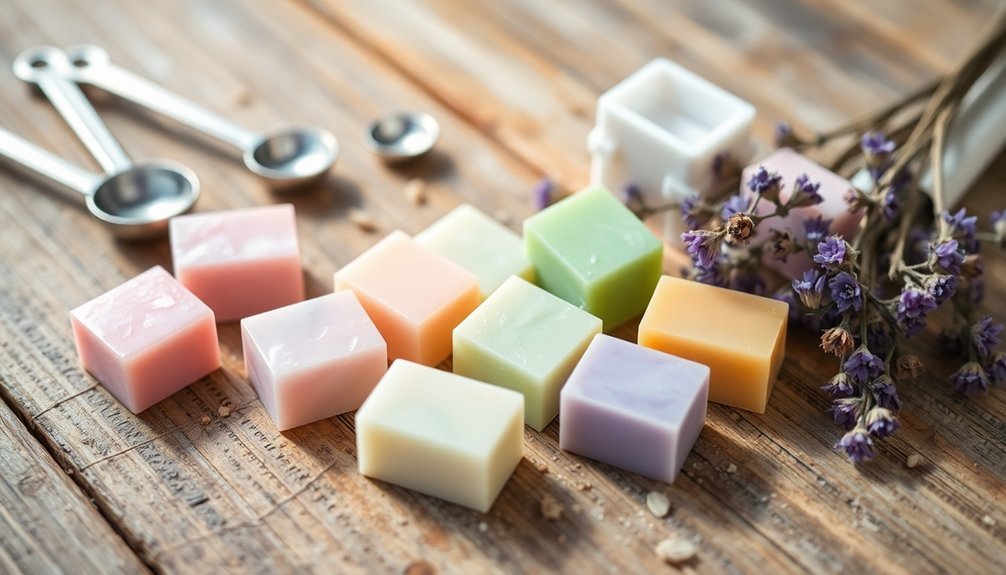
While many commercial soap recipes can seem overwhelming, starting with small batch soap making offers the perfect entry point for both beginners and experienced crafters looking to experiment.
Small batch soap making provides the ideal starting point, whether you're new to the craft or simply want to test creative ideas.
The ideal test batch sizes for newcomers are either 4 ounces (¼ pound) or 8 ounces (½ pound) of oils, which minimize waste while allowing for skill development.
For an 8-oz batch, you'll need just 2.26 oz of distilled water and 1.13 oz of lye solution—proportions that guarantee proper saponification.
Beginner soap makers can easily scale down larger recipes by dividing all ingredients by 5, maintaining the correct ratios throughout.
Loaf molds work perfectly for these small batches, yielding 4-6 bars that provide enough product to test while keeping your financial investment manageable.
Why Small Batches Are Perfect for Soap Making Beginners
Starting with small batches offers you a cost-effective way to learn soap making basics without breaking the bank when mistakes happen.
You'll generate less waste during your learning phase while still producing enough usable product to feel accomplished.
Small-scale production enables you to run more experiments with different ingredients, scents, and techniques, accelerating your growth as a soap maker.
Cost-Effective Learning
Anyone venturing into the world of soap making should consider starting small. With small batches using just 113-227 grams of oils, you'll minimize financial risk while maximizing your learning opportunities.
These compact recipes yield 6-8 bars—plenty for testing without wasting precious ingredients.
The cost-effective nature of small batches empowers you to experiment freely with different recipes, fragrances, and additives. You'll quickly discover what works and what doesn't without breaking the bank.
Each mini-batch becomes a controlled experiment where you can track specific adjustments and improvements.
As you master techniques through these manageable projects, your confidence will naturally grow.
The beauty of limiting yourself to 500g of oils or less is that you're free to embrace creativity without the pressure of potentially wasting expensive materials.
Less Waste, More Experiments
Because small-batch soap making generates minimal waste, it's ideal for beginners enthusiastic to experiment without guilt.
When you work with just 4 or 8 ounces of oil, you'll produce only 6-8 bars—perfect for testing new ideas without overwhelming your storage space or ingredients supply.
Small batches give you freedom to try different fragrances, colorants, and additives without committing significant resources.
Failed a swirl technique? No problem—you've only used minimal materials.
Your creativity can flourish as you test various techniques in a controlled environment.
Understanding Minimum Viable Batch Sizes for Cold Process Soap
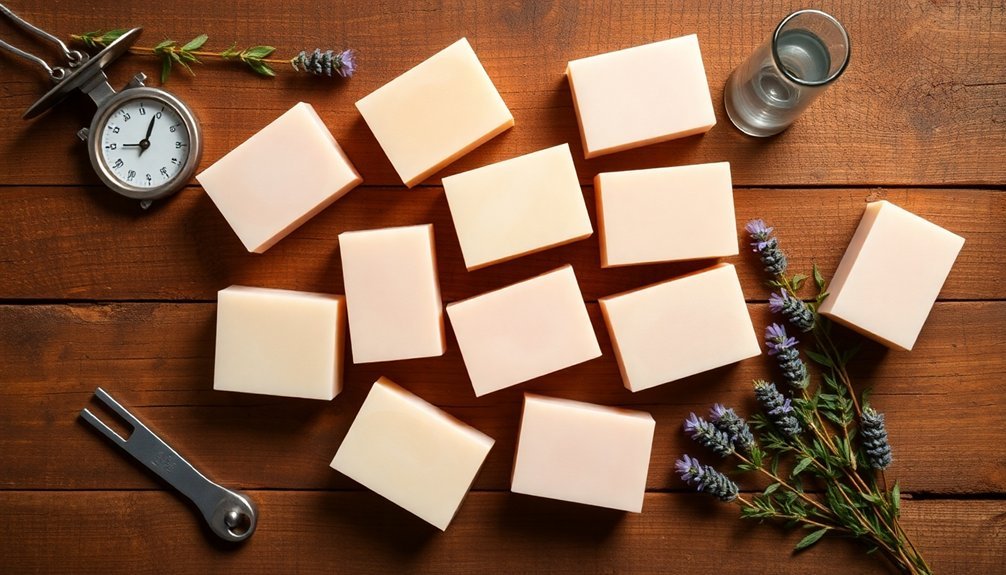
While many beginners feel tempted to create tiny test batches, you'll need to maintain certain minimum quantities for successful soap making. The smallest viable cold process soap batch requires at least 4 ounces (1/4 pound) of oils, with corresponding lye amount of 1.13 oz and 2.26 oz of distilled water.
For better experimentation without compromising soap quality, consider:
- Starting with 8 oz (1/2 pound) batches for more balanced oil composition testing
- Using a standard ratio of 50% olive/rice bran oil, 31% coconut oil, 6% castor oil, and 13% butter
- Recalculating lye amounts precisely when scaling down to guarantee safety
- Leveraging smaller batches to test different additives while minimizing waste
The 4oz Test Batch: Ideal Starting Point for Experimentation
Now that you understand minimum batch requirements, let's focus on the 4oz test batch specifically.
This beginner-friendly size allows you to experiment with minimal investment while you learn the saponification process.
A standard 4oz test batch typically contains 2oz olive/rice bran oil, 1.24oz coconut oil, 0.24oz castor oil, and 0.52oz refined butter.
You'll need just 1.13oz lye and 2.26oz distilled water. Accurate measurements are critical, even at this small scale.
The yield is perfect—just 2-3 soap bars—giving you enough to test fragrance combinations and additives without waste.
For novice soap makers, this approach provides valuable practice before scaling up.
Document your results with each test batch to refine your technique and build confidence.
Equipment Modifications for Tiny Soap Batches
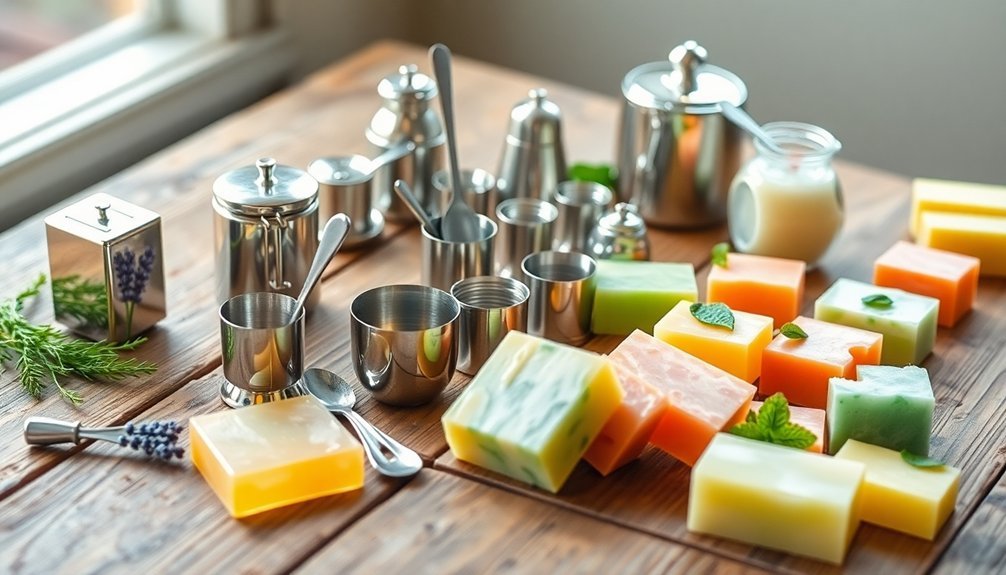
When making tiny soap batches, you'll need appropriately-sized molds that accommodate small quantities without wasting space or materials.
Your toolkit should include micro-scale equipment like precision digital scales measuring to 0.01g and mini immersion blenders specifically designed for small containers.
Setting up a compact workstation with small mixing containers and dedicated mini spatulas will save space and prevent cross-contamination while ensuring your tiny batches turn out perfectly.
Tiny Molds Matter
Selecting the right molds becomes essential as you downsize your soap-making operations. When making small batch soap, single-cavity silicone molds or small loaf molds offer perfect portion control while minimizing waste. A 4-ounce oil test batch fits these tiny molds ideally, giving you enough product to experiment without wasting precious ingredients.
For successful tiny batch soap making, consider these critical elements:
- Use tall, skinny mixing containers that match your tiny molds' volume.
- Invest in precise measuring tools, especially a digital scale.
- Remember that even minor measurement errors greatly impact small batches.
- Approach each batch as an experimentation opportunity with minimal resource investment.
The soap making process becomes more controlled with tiny molds, allowing you to test new recipes and additives efficiently.
Micro Scale Tools
The right miniature equipment transforms tiny soap batches from frustrating to fantastic.
When making small batches, invest in a digital scale that measures in grams—precision matters tremendously as even slight variations can ruin your soap.
Your toolkit should include mini mixing containers like small stainless steel cups that accommodate reduced quantities while allowing proper incorporation.
Pair these with an immersion blender featuring a smaller head to prevent splattering and maintain control.
For dispensing tiny amounts of lye solution, syringes or droppers guarantee precise measurements, especially when working with under 4 ounces of oils.
Always verify your calculations with a lye calculator specifically adjusted for small batches.
Finally, select appropriate small molds—silicone muffin tins work wonderfully for creating perfectly proportioned mini bars that match your micro batching approach.
Space-Saving Setups
Cramped kitchens and tiny apartments needn't deter you from soap-making adventures. With a few strategic equipment modifications, you can create beautiful small batch soap in even the tightest spaces.
Your counter space becomes valuable real estate when working with limited room, so choose tools that serve multiple purposes.
- Replace bulky stand mixers with a compact immersion blender that stores easily in a drawer but still thoroughly incorporates your ingredients.
- Substitute large trays with affordable silicone molds that stack when not in use and create perfect individual bars.
- Utilize a compact digital scale that takes minimal space but guarantees precise measurements every time.
- Create a mobile soap station using repurposed containers for measuring and mixing, storing all essential soap-making tools in one small bin that can be tucked away between sessions.
Converting Standard Recipes to Mini Test Batches
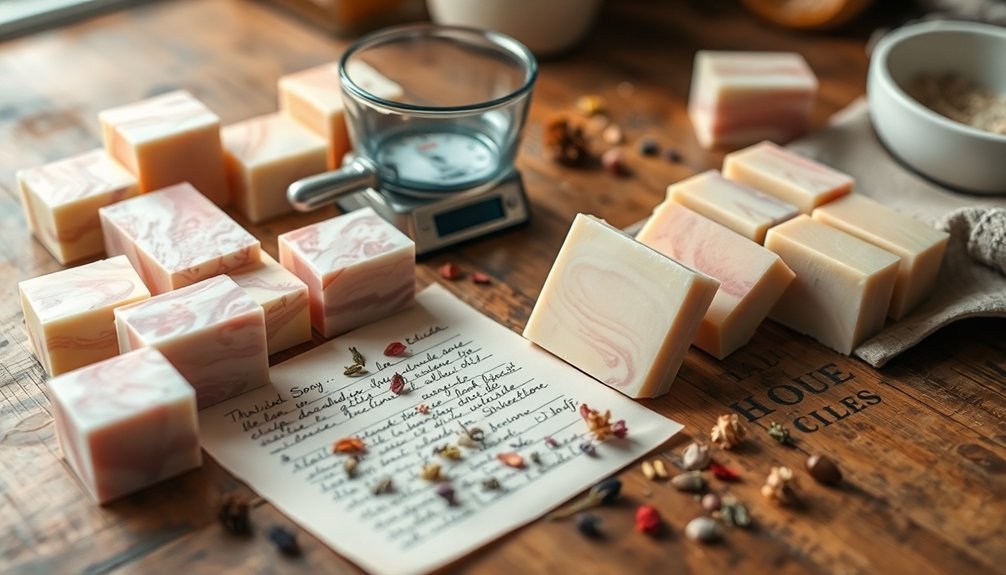
While large soap batches have their place in established production, converting standard recipes into mini test batches offers considerable advantages for both beginners and experienced crafters.
When scaling down a standard 2.5 lb soap recipe, simply divide all ingredients by 5 to create a perfect 8 oz mini test batch.
For this smaller size, you'll need 64g of distilled water and 32g of lye, but always verify these measurements with a lye calculator to guarantee proper saponification.
Maintain the original oil ratio proportions while reducing quantities accordingly. This approach allows for experimentation without wasting materials.
Whether you're working with melt and pour soap or creating from scratch, precise measurements become even more critical in small batches.
This testing method helps perfect your soap recipes before committing to larger production runs.
Essential Oil and Colorant Calculations for Small Batches
When working with small test batches, you'll need to scale your essential oils carefully, using 1/2 teaspoon per 8 ounces of oil base to maintain proper fragrance intensity.
Your colorant additions should follow a simple ratio: 1/4 teaspoon for 4-ounce batches, 1/2 teaspoon for 8-ounce batches, and 1 teaspoon for 16-ounce batches.
Keeping a fragrance-to-base ratio chart handy will guarantee your mini batches maintain the same scent profile and color intensity as your full-sized recipes.
Measuring Essential Oils Accurately
Every successful soap batch begins with precise essential oil measurements. For small batches, calculate based on your total oil weight—use 1 tsp per 16 oz, ½ tsp for 8 oz, or ¼ tsp for 4 oz of oils. This ratio guarantees your fragrance profiles remain balanced without overwhelming your creation.
Add your essential oils when your soap mixture reaches 140-150°F (60-65.6°C) for proper incorporation without seizing.
- Measure by weight – For the most accurate measurements, use a small digital scale rather than volume measurements
- Test before committing – Create tiny test batches to confirm scent strength
- Document everything – Record exact amounts for future replication
- Respect maximum limits – Never exceed 3 tsp of essential oils per typical batch
Scaling Colorant Formulas
Three critical calculations must be mastered for successful small batch soaping: your colorant-to-oil ratio, essential oil strength, and proper scaling techniques.
When working with small batches, precision becomes even more important. For 4-ounce test batches, use ¼ teaspoon of colorants or essential oils to achieve proper ratios. If you're scaling up to 8 ounces of oil, increase to ½ teaspoon of both colorants and fragrance.
Remember that the standard guideline is 1 teaspoon of colorant per 16 ounces of oil. Always measure your additives based on total oil weight in your soap making process. This guarantees consistent results regardless of batch size.
Keep detailed notes of the exact amounts you've used so you can refine your formulas with each experiment. Proper ratios will prevent overpowering scents and achieve balanced coloration.
Fragrance-to-Base Ratio Charts
Now that you understand the basics of scaling, let's explore specific fragrance-to-base ratio charts that will simplify your small batch calculations.
When creating small batches of soap, precision with fragrance oil and colorants becomes even more critical to achieve balanced results.
For ideal fragrance-to-base ratios in your soapmaking process:
- Use 1/4 tsp fragrance oil per 4 oz of soap base, scaling to 1/2 tsp for 8 oz and 1 tsp for 16 oz batches
- Limit essential oils to no more than 3 tsp per pound of oil to prevent skin irritation
- Add colorants at 1/4 tsp per 4 oz of oil for cold process soap, adjusting proportionally for larger batches
- Invest in a digital scale for accurate measurements, especially when working with potent essential oils and concentrated colorants
Molds and Containers Perfect for Micro Soap Making
When making small soap batches, choosing the right molds can dramatically impact your success and satisfaction. Small loaf molds and single-cavity containers are ideal for micro soap making, allowing you to create 4-6 full-size bars without wasting precious ingredients or essential oils.
Silicone molds are your best friend for small batch recipes—their flexibility guarantees your creations release easily, preserving those perfect edges and designs. Look for affordable molds that accommodate 4-ounce (1/4 pound) or 8-ounce (1/2 pound) oil batches for maximum results.
Embrace silicone's flexibility for perfect soap releases every time—even the most intricate designs pop out flawlessly.
Don't overlook unconventional containers like shot glasses for manageable batch sizes. These small vessels are perfect for experimenting with different colors and additives.
Best of all, quality molds typically cost under $10, making them accessible for beginners testing new formulations.
Troubleshooting Common Issues in Small Batch Production
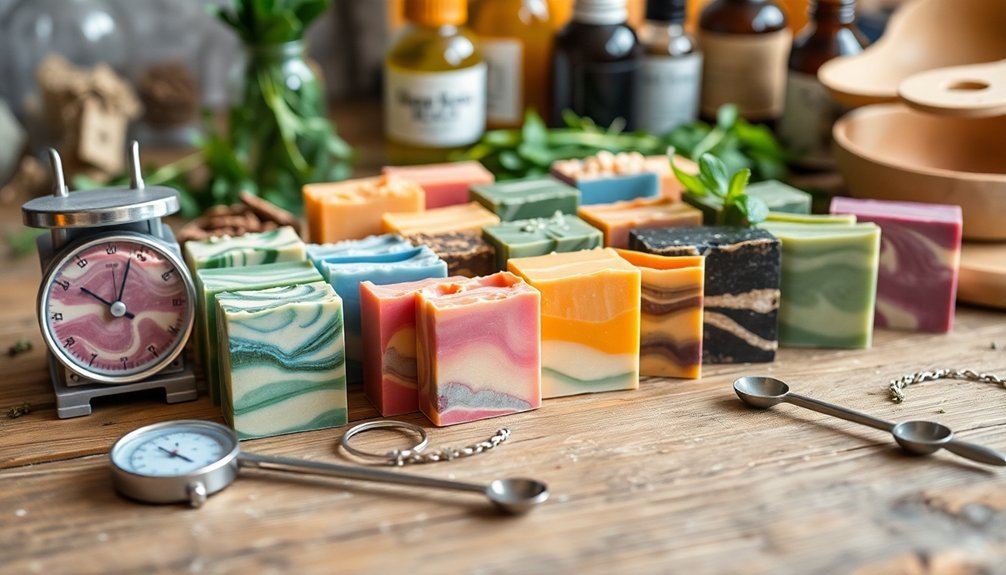
Although small batch soapmaking offers tremendous advantages for experimentation, even experienced crafters encounter challenges that can derail their creations.
When working with 4-8 ounces of oils, precision becomes critical to your soap quality.
- Inaccurate lye measurements – Always use a calibrated scale and lye calculator to prevent dry, crumbly soap or excess alkalinity.
- Trace problems – Watch your soap mixture's consistency; insufficient trace causes mold leaks while over-tracing leads to clumping.
- Documentation gaps – Record all ingredient ratios and superfat levels during experimentation to replicate successes and avoid repeating failures.
- Batch size miscalculations – Aim for 4-8 ounces of oils to minimize waste while still having enough product to properly evaluate results.
Scaling Up: When and How to Move Beyond Test Batches
Once you've mastered the art of small batch soap making and identified recipes that consistently perform well, it's time to contemplate scaling up your production.
Start by confirming your test batches yield reliable, high-quality results before attempting larger volumes.
When increasing batch sizes, always use soap calculators like Soapee or Soapmakers Friend to recalculate your lye and water measurements precisely.
While doubling recipes is generally straightforward, tripling may require adjustments to maintain proper ingredient ratios and soap quality.
Scale up gradually rather than making dramatic jumps in batch size. This methodical approach allows you to monitor how larger quantities affect your soap's performance and consistency.
Document all adjustments to superfat percentages and ingredient proportions during the scaling process to confirm you can replicate successful batches in the future.
Documentation Systems for Small Batch Testing Results
Successful soapmakers understand that meticulous record-keeping forms the backbone of consistent soap production. When testing small batches of soap, your documentation system doesn't need to be complex, but it must be thorough. Track each batch's recipe, including oil types, exact weights, and additives to replicate successful formulations.
The difference between amateur soap dabbling and professional consistency lies in the humble practice of thorough record-keeping.
- Recipe Details – Record all measurements, including oils, lye, water ratios, and superfat percentages for each test batch.
- Process Observations – Note trace times, temperatures, and any challenges encountered during making.
- Curing Documentation – Track color changes, scent retention, and texture development throughout the cure.
- Outcome Analysis – Document your final assessment and specific adjustments to refine formulations for future batches.
A simple spreadsheet or dedicated notebook can transform your soap making from guesswork to precision.
Cost Benefits of Miniature Soap Making Projects
While maintaining detailed records guarantees recipe consistency, the financial advantages of small-batch soapmaking can't be overlooked.
By limiting your batches to 8-16 ounces of oils (around 500g), you'll greatly reduce financial risk associated with failed experiments.
Small batches allow you to test new recipes before committing to larger quantities, ensuring higher quality in your final products. You'll spend less on ingredients while still having freedom to create unique soap creations with various fragrances and additives.
The investment is minimal—affordable molds suitable for small batches typically cost under $10.
This cost-effective approach lets you experiment with different formulations without worrying about excess inventory or wasted materials. You'll build confidence in your soapmaking skills while creating personalized gifts without the pressure of large financial commitments.
Frequently Asked Questions
How Many Bars of Soap Does 1lb Make?
From 1 pound of soap, you'll get 4 standard bars (4oz each) or up to 8 smaller guest-sized bars (2oz each). Your final count depends on your mold size and how much water evaporates during curing.
How Many Bars Does 5 Lbs of Soap Make?
A 5-pound batch of soap will typically yield 30-40 bars, depending on how you cut them. You'll get around 4-6 ounce bars from this size batch, perfect for stocking up your supply.
How to Calculate Soap Batch Size?
To calculate soap batch size, determine your total oil weight first. Use a lye calculator to find precise lye and water amounts. For beginners, start with 4-8 ounces of oils. Always maintain proper ingredient ratios when scaling.
What Is the Average Size of Homemade Soap?
The average size of homemade soap batches typically ranges from 4-16 ounces of oils. You'll find most beginners start with 8 ounces, while more experienced soapers often work with 1-pound (16 oz) batches for efficiency.
In Summary
You've now got all the tools to start your small batch soap making journey! Whether you're testing new fragrance combinations with 4oz batches or gradually scaling up your successful recipes, you'll save money and materials while perfecting your craft. Remember to document your experiments carefully—these tiny batches might lead to your signature soap formula that stands out in the marketplace.

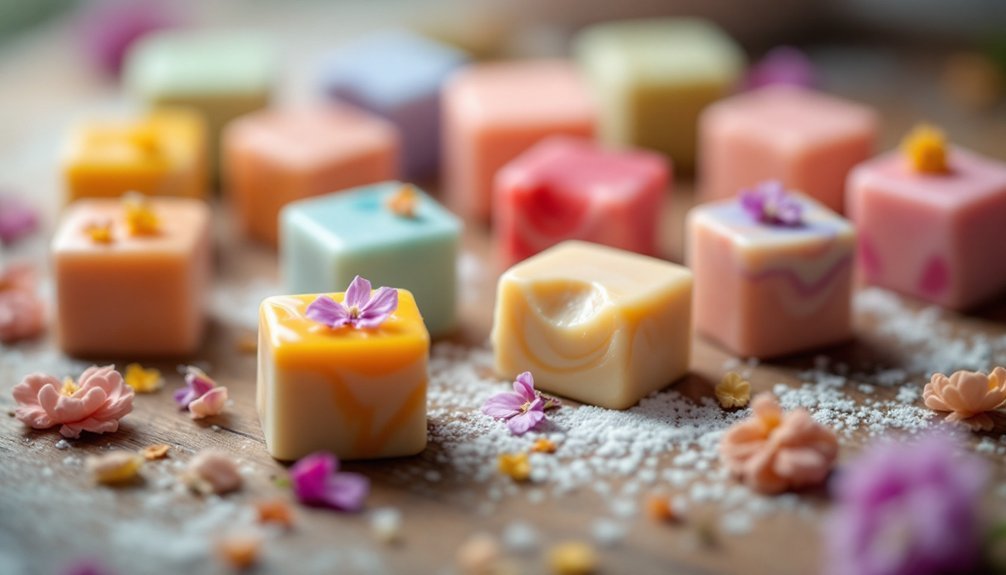



Leave a Reply